QA Automation Engineer Resume Examples
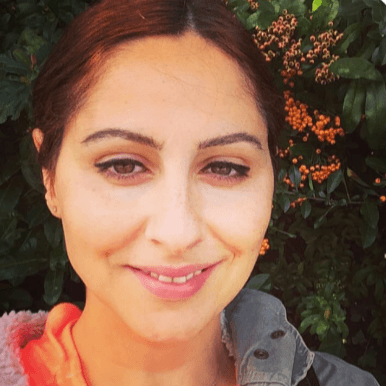
Jul 18, 2024
|
12 min read
Your ultimate QA automation engineer resume guide: ace your job search with a bug-free application that showcases your skills. Debug your way to success with expert tips and real-life examples.
Rated by 348 people
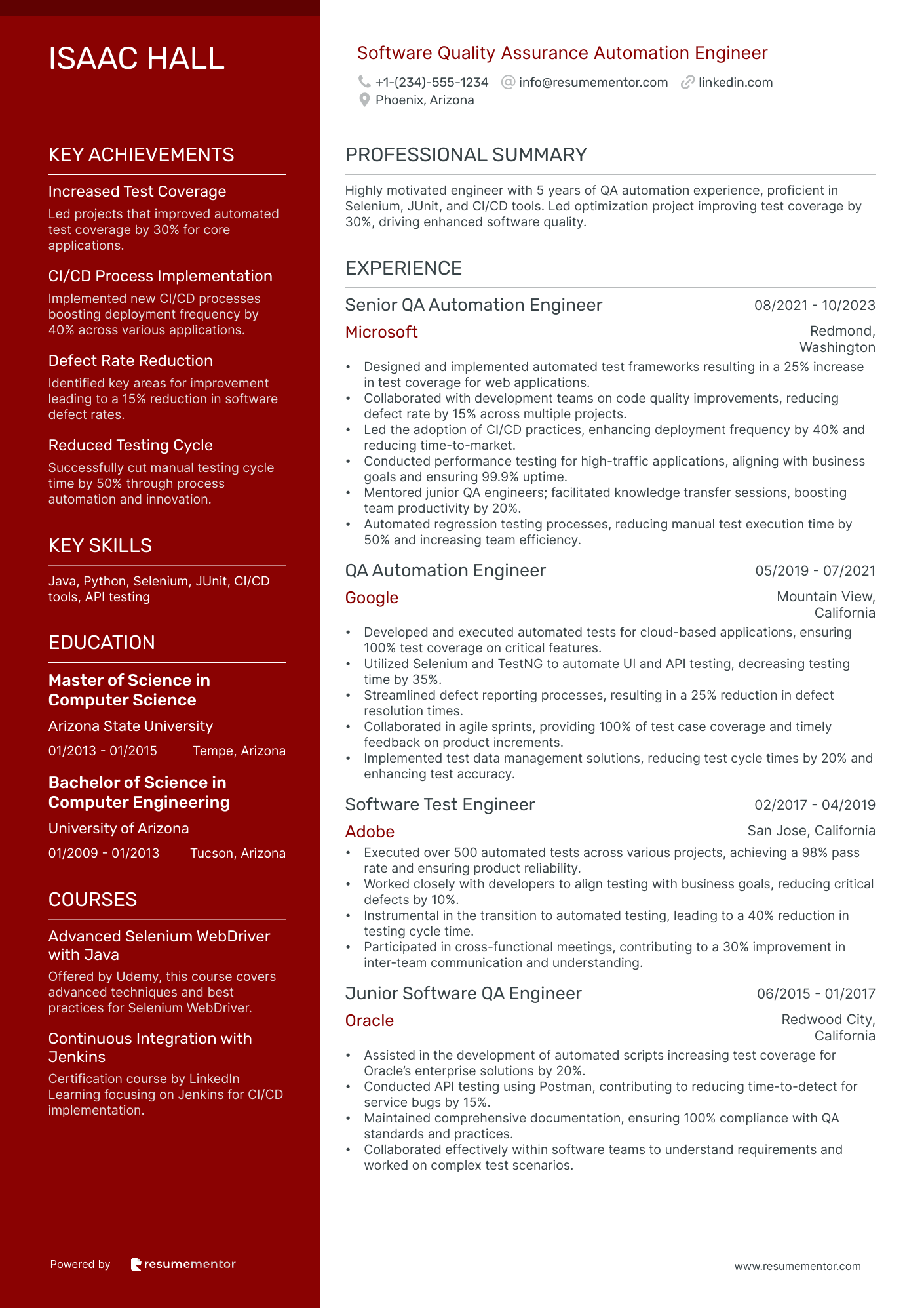
Software Quality Assurance Automation Engineer
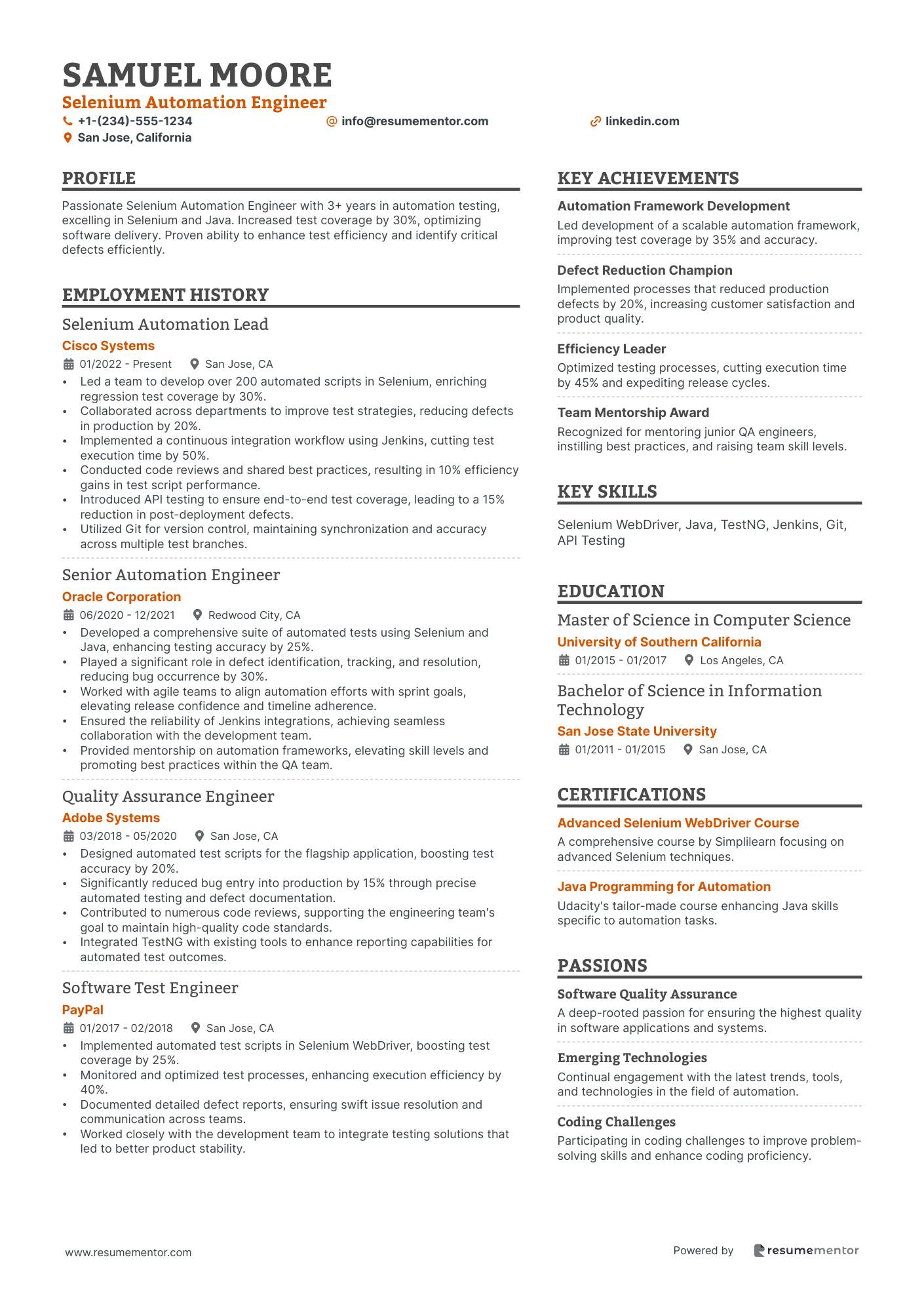
Selenium Automation Engineer
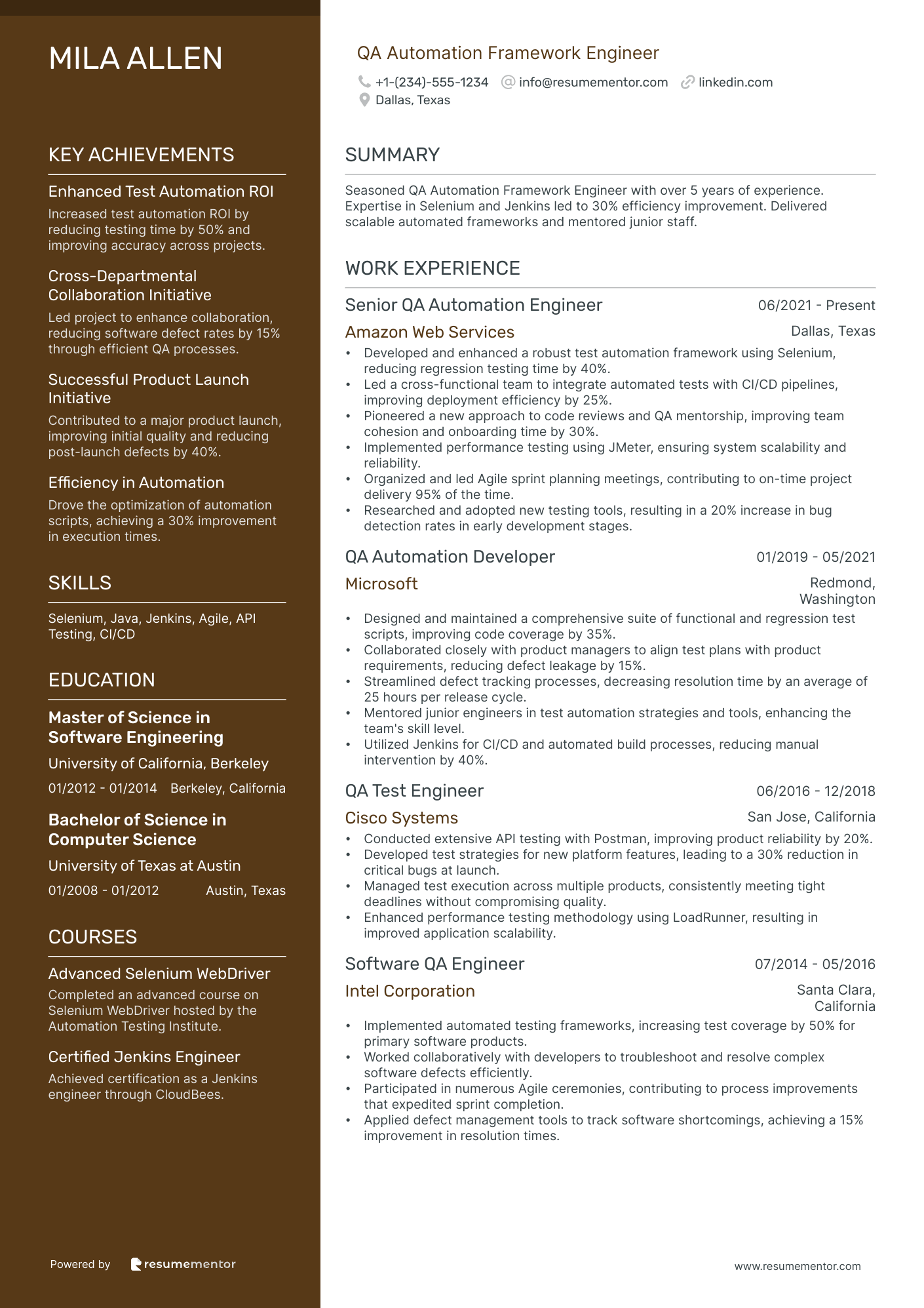
QA Automation Framework Engineer
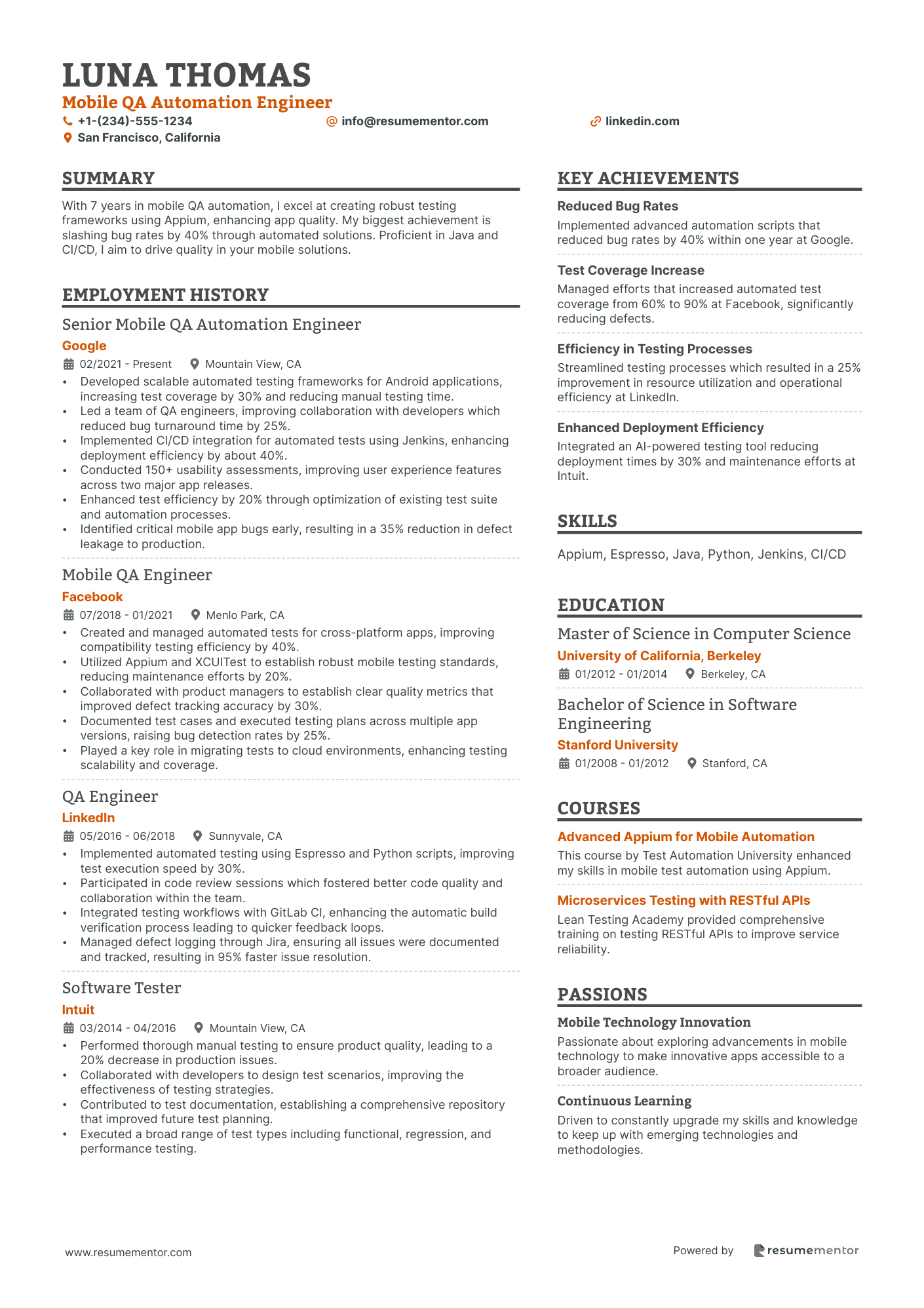
Mobile QA Automation Engineer
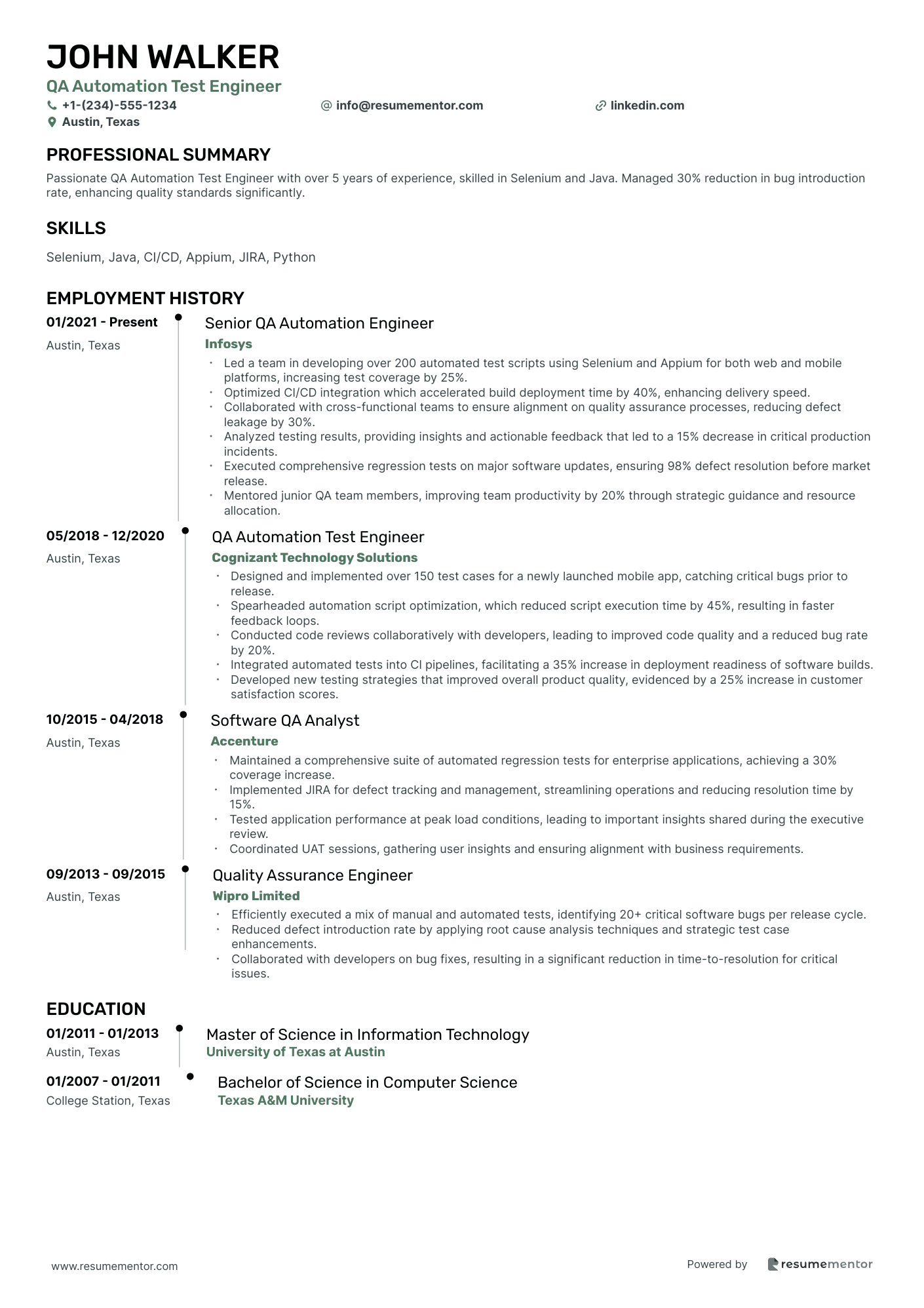
QA Automation Test Engineer
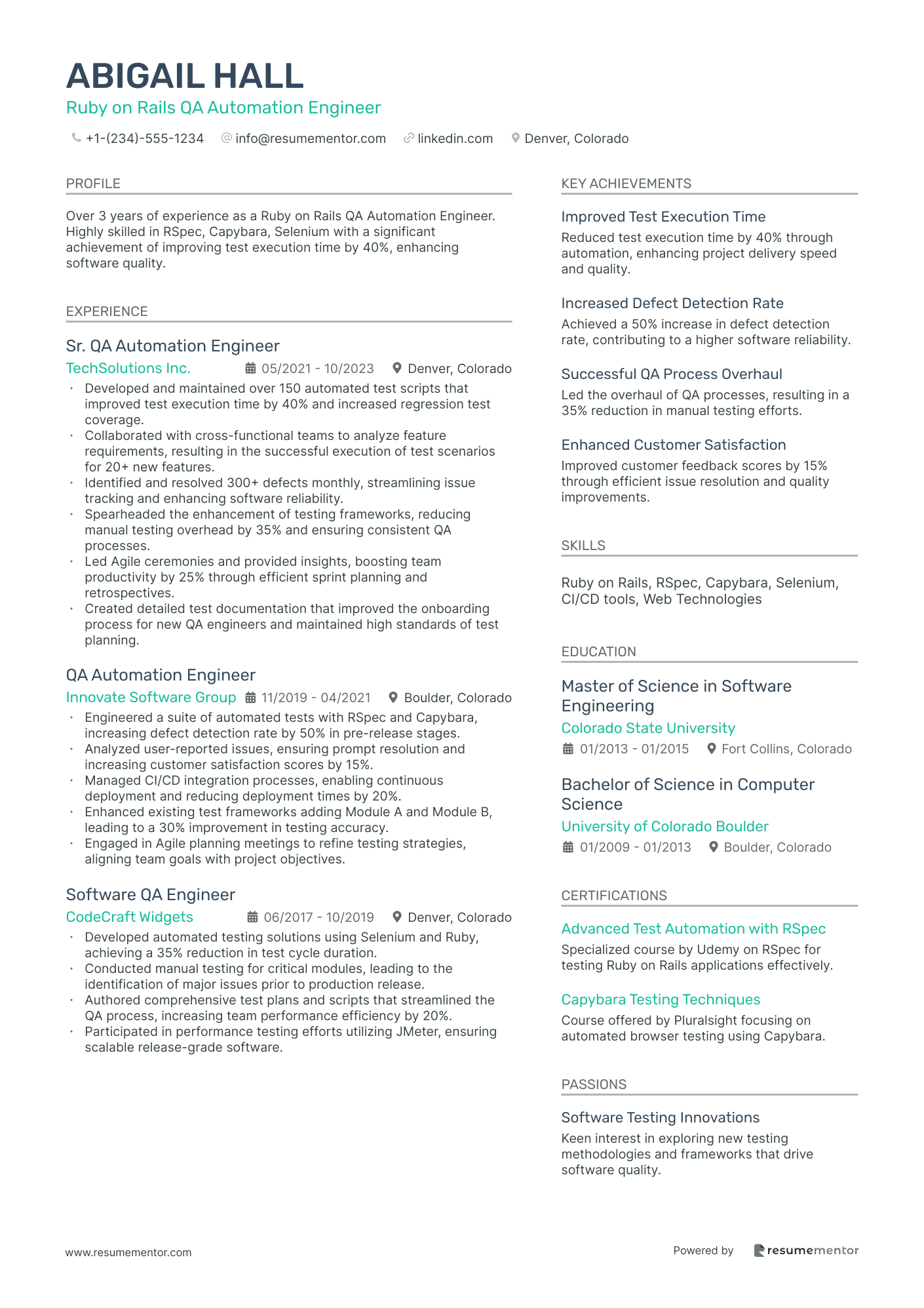
Ruby on Rails QA Automation Engineer
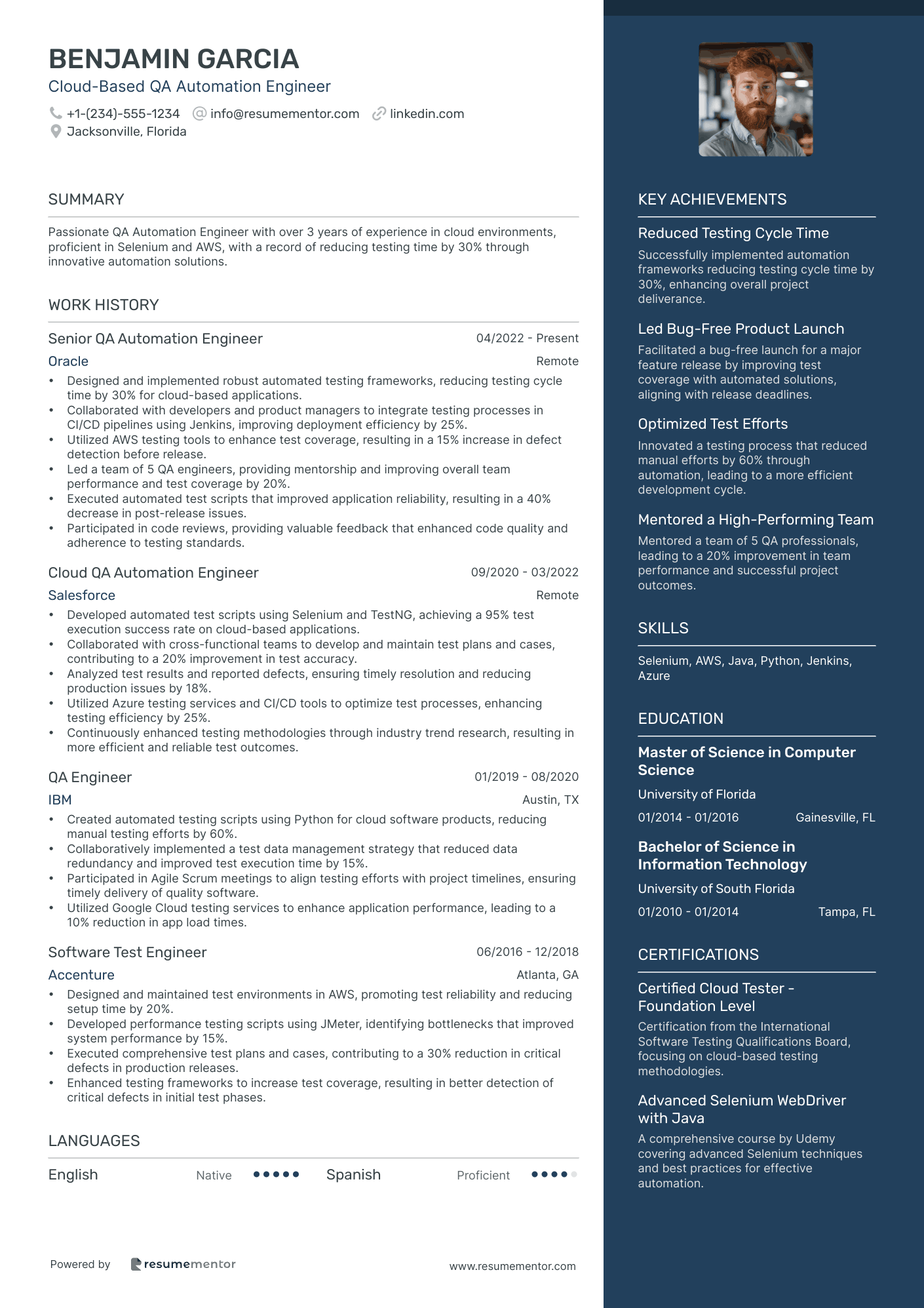
Cloud-Based QA Automation Engineer
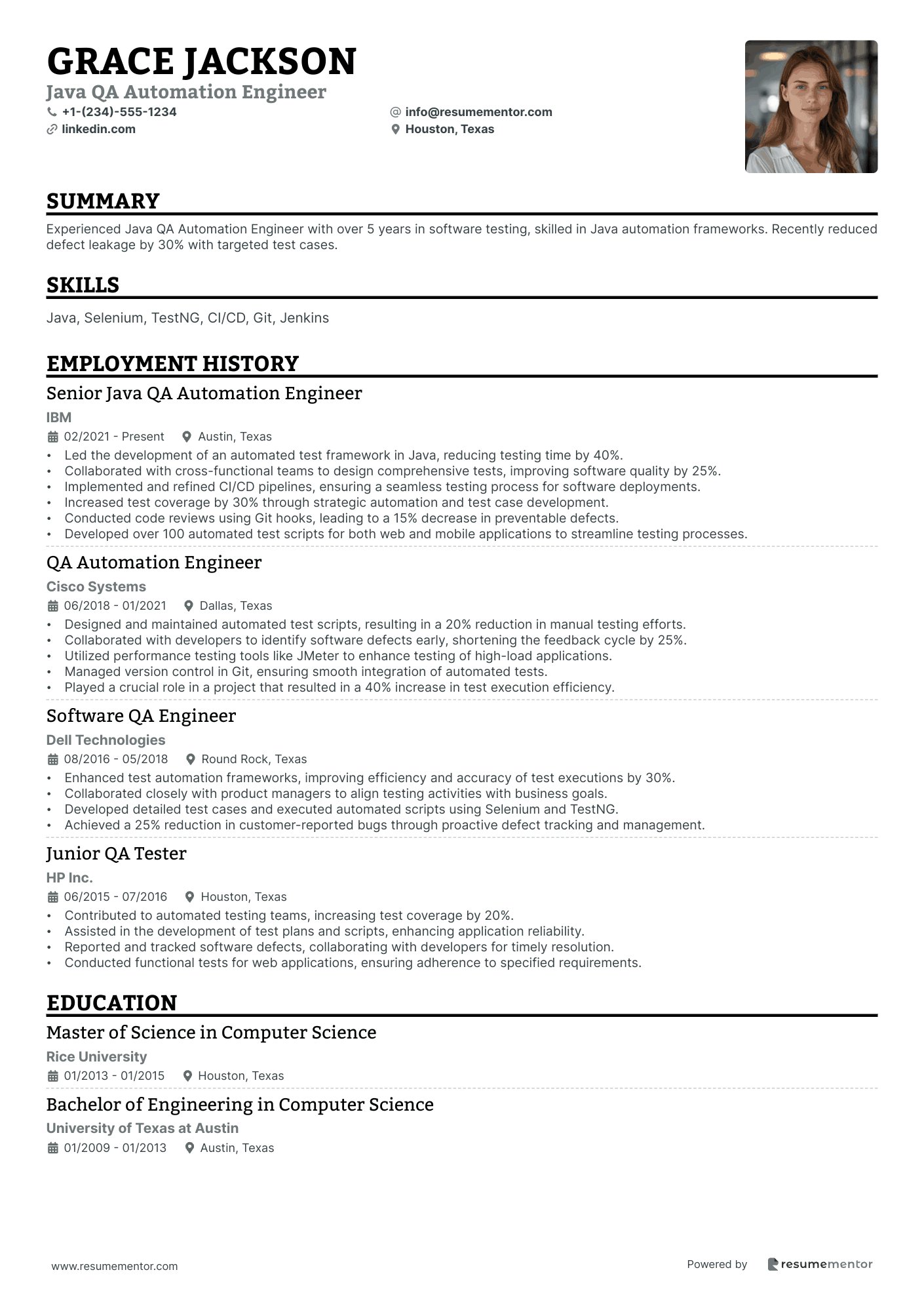
Java QA Automation Engineer

QA Scripting and Automation Engineer

Software Quality Assurance Automation Engineer resume sample
- •Designed and implemented automated test frameworks resulting in a 25% increase in test coverage for web applications.
- •Collaborated with development teams on code quality improvements, reducing defect rate by 15% across multiple projects.
- •Led the adoption of CI/CD practices, enhancing deployment frequency by 40% and reducing time-to-market.
- •Conducted performance testing for high-traffic applications, aligning with business goals and ensuring 99.9% uptime.
- •Mentored junior QA engineers; facilitated knowledge transfer sessions, boosting team productivity by 20%.
- •Automated regression testing processes, reducing manual test execution time by 50% and increasing team efficiency.
- •Developed and executed automated tests for cloud-based applications, ensuring 100% test coverage on critical features.
- •Utilized Selenium and TestNG to automate UI and API testing, decreasing testing time by 35%.
- •Streamlined defect reporting processes, resulting in a 25% reduction in defect resolution times.
- •Collaborated in agile sprints, providing 100% of test case coverage and timely feedback on product increments.
- •Implemented test data management solutions, reducing test cycle times by 20% and enhancing test accuracy.
- •Executed over 500 automated tests across various projects, achieving a 98% pass rate and ensuring product reliability.
- •Worked closely with developers to align testing with business goals, reducing critical defects by 10%.
- •Instrumental in the transition to automated testing, leading to a 40% reduction in testing cycle time.
- •Participated in cross-functional meetings, contributing to a 30% improvement in inter-team communication and understanding.
- •Assisted in the development of automated scripts increasing test coverage for Oracle’s enterprise solutions by 20%.
- •Conducted API testing using Postman, contributing to reducing time-to-detect for service bugs by 15%.
- •Maintained comprehensive documentation, ensuring 100% compliance with QA standards and practices.
- •Collaborated effectively within software teams to understand requirements and worked on complex test scenarios.
Selenium Automation Engineer resume sample
- •Led a team to develop over 200 automated scripts in Selenium, enriching regression test coverage by 30%.
- •Collaborated across departments to improve test strategies, reducing defects in production by 20%.
- •Implemented a continuous integration workflow using Jenkins, cutting test execution time by 50%.
- •Conducted code reviews and shared best practices, resulting in 10% efficiency gains in test script performance.
- •Introduced API testing to ensure end-to-end test coverage, leading to a 15% reduction in post-deployment defects.
- •Utilized Git for version control, maintaining synchronization and accuracy across multiple test branches.
- •Developed a comprehensive suite of automated tests using Selenium and Java, enhancing testing accuracy by 25%.
- •Played a significant role in defect identification, tracking, and resolution, reducing bug occurrence by 30%.
- •Worked with agile teams to align automation efforts with sprint goals, elevating release confidence and timeline adherence.
- •Ensured the reliability of Jenkins integrations, achieving seamless collaboration with the development team.
- •Provided mentorship on automation frameworks, elevating skill levels and promoting best practices within the QA team.
- •Designed automated test scripts for the flagship application, boosting test accuracy by 20%.
- •Significantly reduced bug entry into production by 15% through precise automated testing and defect documentation.
- •Contributed to numerous code reviews, supporting the engineering team's goal to maintain high-quality code standards.
- •Integrated TestNG with existing tools to enhance reporting capabilities for automated test outcomes.
- •Implemented automated test scripts in Selenium WebDriver, boosting test coverage by 25%.
- •Monitored and optimized test processes, enhancing execution efficiency by 40%.
- •Documented detailed defect reports, ensuring swift issue resolution and communication across teams.
- •Worked closely with the development team to integrate testing solutions that led to better product stability.
QA Automation Framework Engineer resume sample
- •Developed and enhanced a robust test automation framework using Selenium, reducing regression testing time by 40%.
- •Led a cross-functional team to integrate automated tests with CI/CD pipelines, improving deployment efficiency by 25%.
- •Pioneered a new approach to code reviews and QA mentorship, improving team cohesion and onboarding time by 30%.
- •Implemented performance testing using JMeter, ensuring system scalability and reliability.
- •Organized and led Agile sprint planning meetings, contributing to on-time project delivery 95% of the time.
- •Researched and adopted new testing tools, resulting in a 20% increase in bug detection rates in early development stages.
- •Designed and maintained a comprehensive suite of functional and regression test scripts, improving code coverage by 35%.
- •Collaborated closely with product managers to align test plans with product requirements, reducing defect leakage by 15%.
- •Streamlined defect tracking processes, decreasing resolution time by an average of 25 hours per release cycle.
- •Mentored junior engineers in test automation strategies and tools, enhancing the team's skill level.
- •Utilized Jenkins for CI/CD and automated build processes, reducing manual intervention by 40%.
- •Conducted extensive API testing with Postman, improving product reliability by 20%.
- •Developed test strategies for new platform features, leading to a 30% reduction in critical bugs at launch.
- •Managed test execution across multiple products, consistently meeting tight deadlines without compromising quality.
- •Enhanced performance testing methodology using LoadRunner, resulting in improved application scalability.
- •Implemented automated testing frameworks, increasing test coverage by 50% for primary software products.
- •Worked collaboratively with developers to troubleshoot and resolve complex software defects efficiently.
- •Participated in numerous Agile ceremonies, contributing to process improvements that expedited sprint completion.
- •Applied defect management tools to track software shortcomings, achieving a 15% improvement in resolution times.
Mobile QA Automation Engineer resume sample
- •Developed scalable automated testing frameworks for Android applications, increasing test coverage by 30% and reducing manual testing time.
- •Led a team of QA engineers, improving collaboration with developers which reduced bug turnaround time by 25%.
- •Implemented CI/CD integration for automated tests using Jenkins, enhancing deployment efficiency by about 40%.
- •Conducted 150+ usability assessments, improving user experience features across two major app releases.
- •Enhanced test efficiency by 20% through optimization of existing test suite and automation processes.
- •Identified critical mobile app bugs early, resulting in a 35% reduction in defect leakage to production.
- •Created and managed automated tests for cross-platform apps, improving compatibility testing efficiency by 40%.
- •Utilized Appium and XCUITest to establish robust mobile testing standards, reducing maintenance efforts by 20%.
- •Collaborated with product managers to establish clear quality metrics that improved defect tracking accuracy by 30%.
- •Documented test cases and executed testing plans across multiple app versions, raising bug detection rates by 25%.
- •Played a key role in migrating tests to cloud environments, enhancing testing scalability and coverage.
- •Implemented automated testing using Espresso and Python scripts, improving test execution speed by 30%.
- •Participated in code review sessions which fostered better code quality and collaboration within the team.
- •Integrated testing workflows with GitLab CI, enhancing the automatic build verification process leading to quicker feedback loops.
- •Managed defect logging through Jira, ensuring all issues were documented and tracked, resulting in 95% faster issue resolution.
- •Performed thorough manual testing to ensure product quality, leading to a 20% decrease in production issues.
- •Collaborated with developers to design test scenarios, improving the effectiveness of testing strategies.
- •Contributed to test documentation, establishing a comprehensive repository that improved future test planning.
- •Executed a broad range of test types including functional, regression, and performance testing.
QA Automation Test Engineer resume sample
- •Led a team in developing over 200 automated test scripts using Selenium and Appium for both web and mobile platforms, increasing test coverage by 25%.
- •Optimized CI/CD integration which accelerated build deployment time by 40%, enhancing delivery speed.
- •Collaborated with cross-functional teams to ensure alignment on quality assurance processes, reducing defect leakage by 30%.
- •Analyzed testing results, providing insights and actionable feedback that led to a 15% decrease in critical production incidents.
- •Executed comprehensive regression tests on major software updates, ensuring 98% defect resolution before market release.
- •Mentored junior QA team members, improving team productivity by 20% through strategic guidance and resource allocation.
- •Designed and implemented over 150 test cases for a newly launched mobile app, catching critical bugs prior to release.
- •Spearheaded automation script optimization, which reduced script execution time by 45%, resulting in faster feedback loops.
- •Conducted code reviews collaboratively with developers, leading to improved code quality and a reduced bug rate by 20%.
- •Integrated automated tests into CI pipelines, facilitating a 35% increase in deployment readiness of software builds.
- •Developed new testing strategies that improved overall product quality, evidenced by a 25% increase in customer satisfaction scores.
- •Maintained a comprehensive suite of automated regression tests for enterprise applications, achieving a 30% coverage increase.
- •Implemented JIRA for defect tracking and management, streamlining operations and reducing resolution time by 15%.
- •Tested application performance at peak load conditions, leading to important insights shared during the executive review.
- •Coordinated UAT sessions, gathering user insights and ensuring alignment with business requirements.
- •Efficiently executed a mix of manual and automated tests, identifying 20+ critical software bugs per release cycle.
- •Reduced defect introduction rate by applying root cause analysis techniques and strategic test case enhancements.
- •Collaborated with developers on bug fixes, resulting in a significant reduction in time-to-resolution for critical issues.
Ruby on Rails QA Automation Engineer resume sample
- •Developed and maintained over 150 automated test scripts that improved test execution time by 40% and increased regression test coverage.
- •Collaborated with cross-functional teams to analyze feature requirements, resulting in the successful execution of test scenarios for 20+ new features.
- •Identified and resolved 300+ defects monthly, streamlining issue tracking and enhancing software reliability.
- •Spearheaded the enhancement of testing frameworks, reducing manual testing overhead by 35% and ensuring consistent QA processes.
- •Led Agile ceremonies and provided insights, boosting team productivity by 25% through efficient sprint planning and retrospectives.
- •Created detailed test documentation that improved the onboarding process for new QA engineers and maintained high standards of test planning.
- •Engineered a suite of automated tests with RSpec and Capybara, increasing defect detection rate by 50% in pre-release stages.
- •Analyzed user-reported issues, ensuring prompt resolution and increasing customer satisfaction scores by 15%.
- •Managed CI/CD integration processes, enabling continuous deployment and reducing deployment times by 20%.
- •Enhanced existing test frameworks adding Module A and Module B, leading to a 30% improvement in testing accuracy.
- •Engaged in Agile planning meetings to refine testing strategies, aligning team goals with project objectives.
- •Developed automated testing solutions using Selenium and Ruby, achieving a 35% reduction in test cycle duration.
- •Conducted manual testing for critical modules, leading to the identification of major issues prior to production release.
- •Authored comprehensive test plans and scripts that streamlined the QA process, increasing team performance efficiency by 20%.
- •Participated in performance testing efforts utilizing JMeter, ensuring scalable release-grade software.
- •Managed test case development and execution, supporting more than 15 project releases annually.
- •Facilitated defect triaging sessions, reducing defect resolution time by 25% through effective prioritization.
- •Implemented a test management tool, which reduced test case redundancy and improved reporting accuracy.
- •Enhanced QA processes through training sessions, increasing team competency in automated testing tools.
Cloud-Based QA Automation Engineer resume sample
- •Designed and implemented robust automated testing frameworks, reducing testing cycle time by 30% for cloud-based applications.
- •Collaborated with developers and product managers to integrate testing processes in CI/CD pipelines using Jenkins, improving deployment efficiency by 25%.
- •Utilized AWS testing tools to enhance test coverage, resulting in a 15% increase in defect detection before release.
- •Led a team of 5 QA engineers, providing mentorship and improving overall team performance and test coverage by 20%.
- •Executed automated test scripts that improved application reliability, resulting in a 40% decrease in post-release issues.
- •Participated in code reviews, providing valuable feedback that enhanced code quality and adherence to testing standards.
- •Developed automated test scripts using Selenium and TestNG, achieving a 95% test execution success rate on cloud-based applications.
- •Collaborated with cross-functional teams to develop and maintain test plans and cases, contributing to a 20% improvement in test accuracy.
- •Analyzed test results and reported defects, ensuring timely resolution and reducing production issues by 18%.
- •Utilized Azure testing services and CI/CD tools to optimize test processes, enhancing testing efficiency by 25%.
- •Continuously enhanced testing methodologies through industry trend research, resulting in more efficient and reliable test outcomes.
- •Created automated testing scripts using Python for cloud software products, reducing manual testing efforts by 60%.
- •Collaboratively implemented a test data management strategy that reduced data redundancy and improved test execution time by 15%.
- •Participated in Agile Scrum meetings to align testing efforts with project timelines, ensuring timely delivery of quality software.
- •Utilized Google Cloud testing services to enhance application performance, leading to a 10% reduction in app load times.
- •Designed and maintained test environments in AWS, promoting test reliability and reducing setup time by 20%.
- •Developed performance testing scripts using JMeter, identifying bottlenecks that improved system performance by 15%.
- •Executed comprehensive test plans and cases, contributing to a 30% reduction in critical defects in production releases.
- •Enhanced testing frameworks to increase test coverage, resulting in better detection of critical defects in initial test phases.
Java QA Automation Engineer resume sample
- •Led the development of an automated test framework in Java, reducing testing time by 40%.
- •Collaborated with cross-functional teams to design comprehensive tests, improving software quality by 25%.
- •Implemented and refined CI/CD pipelines, ensuring a seamless testing process for software deployments.
- •Increased test coverage by 30% through strategic automation and test case development.
- •Conducted code reviews using Git hooks, leading to a 15% decrease in preventable defects.
- •Developed over 100 automated test scripts for both web and mobile applications to streamline testing processes.
- •Designed and maintained automated test scripts, resulting in a 20% reduction in manual testing efforts.
- •Collaborated with developers to identify software defects early, shortening the feedback cycle by 25%.
- •Utilized performance testing tools like JMeter to enhance testing of high-load applications.
- •Managed version control in Git, ensuring smooth integration of automated tests.
- •Played a crucial role in a project that resulted in a 40% increase in test execution efficiency.
- •Enhanced test automation frameworks, improving efficiency and accuracy of test executions by 30%.
- •Collaborated closely with product managers to align testing activities with business goals.
- •Developed detailed test cases and executed automated scripts using Selenium and TestNG.
- •Achieved a 25% reduction in customer-reported bugs through proactive defect tracking and management.
- •Contributed to automated testing teams, increasing test coverage by 20%.
- •Assisted in the development of test plans and scripts, enhancing application reliability.
- •Reported and tracked software defects, collaborating with developers for timely resolution.
- •Conducted functional tests for web applications, ensuring adherence to specified requirements.
QA Scripting and Automation Engineer resume sample
- •Developed and maintained automation scripts using Python, reducing the regression testing cycle by 30%.
- •Enhanced the existing test framework, improving test coverage by 25% and leading to a 15% decrease in production bugs.
- •Collaborated with the development and product teams to gather testing requirements, ensuring test cases align with project goals.
- •Led the CI/CD integration of testing processes with Jenkins, resulting in a 20% increase in deployment efficiency.
- •Managed a team of four QA analysts, providing training on best practices in automation and improving team productivity by 40%.
- •Identified critical defects and inconsistencies in new software releases, ensuring product quality before launch.
- •Designed and implemented an automated testing framework using Selenium and TestNG, boosting testing efficiency by 35%.
- •Successfully executed over 500 automated test cases, identifying key issues in early stages and improving application stability.
- •Participated in Agile ceremonies as a QA representative, improving collaboration across 3 multifaceted project teams.
- •Contributed to API test automation using Postman, significantly enhancing test reliability by 20%.
- •Documented and tracked over 1200 defects using JIRA, coordinating with developers to expedite resolution.
- •Created and executed automation scripts that cut testing time by 28%, improving turnaround for client feedback.
- •Engaged in continuous integration efforts, setting up jobs in Jenkins that elevated build success rates by 15%.
- •Interfaced between quality assurance and development teams, enhancing cross-functional team communication.
- •Devised test plans and strategies that improved defect identification and reduced post-release issues by 10%.
- •Assisted in manual testing process improvements, resulting in 15% time savings in test execution.
- •Conducted exploratory testing across multiple projects, identifying key areas for test automation.
- •Executed functional and regression tests, maintaining high standards of product quality and user satisfaction.
- •Contributed to the design of test data sets that increased testing accuracy by 12%.
Crafting your resume as a QA automation engineer can feel like solving a complex puzzle. Each piece—your skills, experience, and achievements—needs to fit together seamlessly. It's more than listing abilities; it's about showcasing how you've made a tangible impact in your role. The challenge is capturing both technical depth and clear, compelling achievements.
An effective structure highlights your strengths, and using a resume template can guide you through this process. Templates provide a framework that allows you to focus on crafting quality content, rather than getting bogged down by format.
Expressing the value of your daily work is crucial. When you highlight projects where you've improved efficiency or saved resources, you’re speaking directly to what potential employers care about—results. Each role you list should not only detail your responsibilities but spotlight how you excelled in them.
Tailoring your resume for each application further sets you apart. By weaving in keywords from the job description, you not only capture a recruiter’s attention but also navigate applicant tracking systems with ease. A personalized resume demonstrates your dedication and precision, key traits that every employer seeks.
Lastly, use straightforward language. Avoid technical jargon that might confuse those unfamiliar with the specifics of your field. Remember, your resume is the gateway to potential opportunities. Make it a clear and compelling reflection of your skills and potential.
Key Takeaways
- The article emphasizes that your resume should go beyond listing your skills, focusing on documenting the tangible impact you've made in past roles.
- Using a resume template can streamline format concerns, allowing you to concentrate on crafting quality, targeted content for potential employers.
- Highlighting quantifiable achievements and tailoring your resume to specific job applications through the use of relevant keywords can set you apart.
- Straightforward language avoids confusion for non-technical readers and strengthens the overall reach of your resume to potential recruiters.
- Strategically framing skills, experience, education, and certifications forms the backbone of a well-structured resume, ensuring clear presentation of your qualifications.
What to focus on when writing your QA automation engineer resume
Your QA automation engineer resume should highlight your expertise in automated testing and software quality assurance, making it clear how you develop automation scripts and work with testing frameworks to ensure software reliability.
How to structure your QA automation engineer resume
- Contact Information: Start with your name, phone number, email, and LinkedIn profile—make sure all details are professional and formatted simply for easy readability. The goal is to provide a seamless way for recruiters to get in touch, with each detail serving as a quick entry point into further discussions.
- Professional Summary: Follow with a brief overview of your QA automation experience—emphasize your strengths in specific tools and programming languages like Selenium and Jenkins. This section is crucial for grabbing attention early, offering a snapshot of why you’re a great fit for the role.
- Technical Skills: Next, list your skills in programming languages such as Python and Java—include your expertise in testing tools like JUnit and TestNG. Clearly highlight these skills to showcase your technical acumen and ability to handle complex automation tasks effectively.
- Work Experience: Then, detail your previous roles and achievements in QA automation—make sure to use bullet points and start with strong action verbs like "developed," "implemented," or "optimized" to communicate your impact. This section should demonstrate how you've applied your skills to support successful projects.
- Education: Afterward, mention your degrees and certifications—with particular emphasis on courses in software testing or quality assurance to underline the relevance of your educational background to the QA field. This helps establish your foundational knowledge in technology and testing methodologies.
- Projects: Finally, share insights into projects you've contributed to—articulate the technologies you used, your role, and concrete results to show your ability to deliver impactful results.
These sections collectively form the backbone of your resume format—below, we will cover each section more in-depth to ensure your resume truly stands out.
Which resume format to choose
As a QA automation engineer focusing on how to write an effective resume, the reverse-chronological format is your best bet. It emphasizes your latest experience, which is essential in a tech-driven industry that values current expertise. Selecting the right font can make a difference in readability and first impressions. Consider Rubik, Lato, and Raleway; these modern fonts bring a clean, professional look without distracting from your achievements. Always save your resume as a PDF. This ensures your formatting stays intact, making your resume look polished on any device a potential employer might use. Use one-inch margins on each side to keep your document neat and easy to navigate, helping your skills and accomplishments stand out to hiring managers. This approach ensures every aspect of your resume supports a clear and compelling presentation of your qualifications.
How to write a quantifiable resume experience section
Crafting the experience section of your QA automation engineer resume is crucial because it lets you highlight your skills and achievements. Focus on tangible outcomes that show impact. Structure this section with clear job titles, companies, and dates to make it easy to follow. By using reverse chronological order, you can direct attention to your most recent and relevant experience. Only include roles that align with the job you want, ensuring relevance. Tailor this section to the job ad by mirroring the desired skills and qualifications. Action words like "developed" and "implemented" convey your contributions and achievements effectively. In tech roles, quantifiable achievements are critical as they demonstrate your impact in concrete terms. Generally, you should go back 10–15 years or include three to five job roles, focusing on those that showcase your strongest qualifications.
- •Developed and executed 500+ automated test scripts, reducing manual testing time by 40%.
- •Led a team of 4 in implementing a new testing framework, resulting in a 30% increase in test coverage.
- •Reduced software bugs by 25% through streamlined automation processes.
- •Collaborated with cross-functional teams to enhance product reliability, improving customer satisfaction by 20%.
This experience section skillfully ties numbers to achievements, effectively demonstrating your impact as a QA automation engineer. By using specific data, you can show how your efforts lead to efficient work and improved outcomes. Each bullet point builds on the previous one, emphasizing key skills like leadership and collaboration. Highlighting quantifiable results shows your knack for driving technical advancements and meeting industry demands. By tailoring your experiences to fit potential employers’ needs, you distinguish yourself as a strong candidate. Maintaining a focused and concise structure helps keep the reader’s attention, while clear language ensures the section is both engaging and easy to understand.
Skills-Focused resume experience section
A skills-focused QA Automation Engineer resume experience section should highlight your strengths in test automation, problem-solving, and collaboration. Start by naming this section with a clear focus like "Test Automation Expertise" to immediately convey your key area of expertise. Demonstrating tangible outcomes from your efforts is crucial, so aim to quantify improvements, efficiencies, or savings where possible. Use each bullet point to portray your contributions to projects and the positive effects you had on your team or company, weaving a coherent narrative of your professional journey.
Ensure that each bullet emphasizes a particular aspect of your technical skills or achievements. This might involve creating and managing automated test scripts or working closely with developers to refine testing frameworks, showcasing a continuous thread of technical proficiency. Including details about specific tools or programming languages reinforces your tech competencies and the seamless integration into your work. Overall, each entry should illustrate not just your activities but also the significant impact they had on organizational projects, giving a comprehensive and connected view of your skills and contributions in the field of QA Automation.
QA Automation Engineer
Tech Innovations Corp
Jan 2019 - Present
- Developed and maintained over 50 automated test scripts using Selenium, boosting test coverage by 30%.
- Worked with the development team to integrate test automation into the CI/CD pipeline, cutting production defects by 25%.
- Led a team of 3 QA engineers in revamping the testing framework, improving testing efficiency by 40%.
- Trained colleagues on test automation best practices, leading to a 20% increase in testing speed.
Problem-Solving Focused resume experience section
A problem-solving-focused QA automation engineer resume experience section should clearly showcase your ability to effectively address and overcome challenges using your technical skills. Start by selecting a role or project where your problem-solving abilities were key. Clearly identify your specific role and detail the issues you encountered, using straightforward language to convey both the complexity of the problems and how you adeptly handled them. Emphasize tangible results, such as time saved or improved efficiency, to illustrate your contributions. Bullet points can help format these accomplishments in a way that is easy to digest.
For each bullet point, begin with the challenge you faced and seamlessly transition into the actions you took, followed by the outcomes achieved. This approach highlights your proactive involvement and the value you bring. Whenever possible, quantify your achievements, like the percentage by which errors were reduced. By doing this, you paint a vivid picture of the concrete benefits you could offer to future employers.
QA Automation Engineer
Tech Solutions Co.
Jan 2022 - Mar 2023
- Tackled integration issues by designing a new automated testing framework, reducing manual testing time by 40%.
- Implemented a robust error tracking system, which decreased test failures by 30%.
- Collaborated closely with developers to identify and resolve code bugs, resulting in a 20% increase in product stability.
- Led a team of 5 engineers to streamline the testing process, achieving a 25% faster release cycle.
Growth-Focused resume experience section
A growth-focused QA automation engineer resume experience section should highlight your major achievements and contributions in a cohesive way. Start by showcasing your impact in previous positions, which helps potential employers see the concrete value you bring. It's essential to mention both the projects you've been involved with and the technologies you've used, as this demonstrates your expertise and adaptability across different scenarios.
To improve readability, organize your experience with bullet points. Begin each bullet with a strong action verb, then provide a detailed yet clear description of your responsibilities and successes. Directly tie your specific achievements, like reducing release times, boosting test coverage, or fostering team collaboration, to your overall contribution in the workplace. These details make your experience section not only memorable but also a testament to your capability in making substantial contributions to any team.
Senior QA Automation Engineer
Tech Innovations Ltd
January 2020 - Present
- Implemented a new test automation framework that cut test execution time by 30%
- Increased test coverage by 25% with additional automated test cases
- Worked closely with developers to catch critical bugs early, enhancing product quality and speeding up releases
- Trained and guided junior team members, boosting their productivity by 40%
Innovation-Focused resume experience section
A QA Automation Engineer Innovation-Focused resume experience section should demonstrate your ability to bring creative solutions to your roles. Emphasize the unique ways you've improved processes, embraced new tools, and streamlined workflows with innovative strategies. Use action words to convey your contributions effectively, making sure each bullet point highlights how your initiatives led to enhanced efficiency, accuracy, or product quality. By connecting your work to concrete outcomes like reduced bug rates or accelerated testing, you show your impact.
Organize your experience chronologically, starting with your most recent position, and illustrate your strengths in adapting and pioneering change. Include quantifiable metrics, like percentage increases in productivity or decreases in error rates, to outline the significant effects of your efforts. Maintain clear and concise writing, ensuring each sentence builds on the last to deepen the reader's understanding of your skills and achievements. Here's a structured example:
QA Automation Engineer
Tech Innovators Inc
June 2020 - Present
- Created a custom automation framework that slashed test execution time by 40%.
- Introduced AI-based testing tools, cutting bug detection efforts by 25%.
- Led a team in adopting continuous testing, speeding up release cycles by 15%.
- Revamped existing test cases, increasing overall coverage by 20%.
Write your QA automation engineer resume summary section
A QA-focused Automation Engineer resume summary should clearly showcase your strengths and experiences. Highlighting your achievements and skills in a way that aligns with the target job is crucial. Here's a JSON example to illustrate how you might present your experience:
This summary effectively communicates your experience, skills, and the measurable impact you've made. It allows potential employers to quickly understand your value. When crafting your personal description, aim for a tone that combines clarity with confidence. Straightforward language helps to underscore your strongest attributes. To really stand out, weave in examples of your past achievements. It's important to grasp the difference between a resume summary and an objective. A summary offers an overview of your career and skills, while an objective outlines the skills you want to develop. For recent graduates, an objective might illustrate a desire for growth. A resume profile is similar to a summary but may include career goals as well. In contrast, a summary of qualifications lists key achievements and skills point by point. Whether you choose a summary or an objective, tailor it to the specific job and highlight your accomplishments clearly. Emphasize what makes you unique to set yourself apart. Using active language will show that you take initiative and achieve results. This approach enhances the likelihood of catching a recruiter's attention.
Listing your QA automation engineer skills on your resume
A skills-focused QA Automation Engineer resume should emphasize the abilities vital to your role. You have the option to feature your skills in a dedicated section or integrate them throughout your work experience and summary. The key is to clearly demonstrate the strengths you bring to the role.
Among your strengths, soft skills such as teamwork and communication play a crucial role in collaborating effectively within teams. Meanwhile, hard skills—your technical abilities like programming languages and testing tools—are fundamental to fulfilling job requirements successfully.
These skills and strengths serve as essential keywords within your resume, helping it stand out to applicant tracking systems (ATS) and hiring managers. By strategically using these keywords, you enhance your chances of being selected for an interview.
Consider this streamlined example of a standalone skills section:
This example is effective due to its concise focus on key skills, pinpointing what is most relevant to a QA Automation Engineer. Each skill is specific, demonstrating your capabilities and aligning your expertise with what the job demands.
Best hard skills to feature on your QA automation engineer resume
When showcasing hard skills on your QA Automation Engineer resume, emphasize your technical expertise and ability to meet the role's technological demands. They illustrate how you use tools and methods to automate and improve software testing. Key skills include:
Hard Skills
- Test Automation
- Selenium
- JUnit
- TestNG
- API Testing
- Java
- JavaScript
- Python
- Load Testing
- Cucumber
- Continuous Integration
- Jenkins
- Performance Testing
- Agile/Scrum Methodologies
- Version Control (e.g., Git)
Best soft skills to feature on your QA automation engineer resume
Soft skills in your resume should express your personal attributes that support team collaboration and success in a QA Automation Engineer role. They highlight your ability to work well with others, solve problems, and adapt to evolving scenarios. Essential soft skills include:
Soft Skills
- Communication
- Problem-solving
- Attention to detail
- Teamwork
- Flexibility
- Time management
- Critical thinking
- Adaptability
- Analytical skills
- Creative thinking
- Empathy
- Conflict resolution
- Patience
- Initiative
- Organizational skills
How to include your education on your resume
The education section is an important part of your QA automation engineer resume. It helps showcase your foundational knowledge and can set you apart from other candidates. Tailor this section to the job you're applying for by only including relevant education. Irrelevant education can clutter your resume and distract from your qualifications. If your GPA is strong and relevant, include it in this section. List your GPA as "3.8/4.0" and mention any honors like "cum laude" directly after the degree. Clearly state your degree, such as "Bachelor of Science in Computer Science."
Here is a wrong example:
Here is a right example:
The second example is effective because it highlights a relevant degree for a QA automation engineer position. "Bachelor of Science in Computer Science" directly relates to the field. "Cum laude" distinguishes the candidate's academic success. The inclusion of a strong GPA further strengthens their qualifications. The date range indicates recent education, keeping skills competitive. This focused approach aids in clearly and efficiently communicating qualifications.
How to include QA automation engineer certificates on your resume
Including a certificates section is an important part of your QA automation engineer resume. Certificates help demonstrate your skills and qualifications to potential employers. List the certificate's name clearly. Include the date when you obtained it. Add the issuing organization to give it credibility. Certificates can also be included in the header for quick attention. For example, write: “Certified Selenium Professional – ISTQB.”
Here is a good example of a standalone certificates section. Such a section shows your accomplishments at a glance.
This example is good because it clearly shows the key certifications relevant to a QA automation engineer role. Each certification is listed with its accurate name and issuing organization. This gives potential employers an easy way to see your qualifications. Include only certificates that are current and highly relevant to your field. This approach ensures your resume remains concise but impactful.
Extra sections to include in your QA automation engineer resume
When crafting your resume as a QA automation engineer, there are a few additional sections you might want to consider to give a holistic view of your skills, personality, and experiences. These sections can help you stand out to potential employers by showcasing facets of yourself that are not covered in the core sections of your resume.
Language section—List your language proficiencies to highlight your ability to work in multilingual environments. This shows your adaptability and capacity to communicate with diverse teams, potentially opening up more job opportunities.
Hobbies and interests section—Add hobbies and interests to give potential employers more insight into your personality. Including activities related to tech or problem-solving can underscore your passion for the field.
Volunteer work section—Describe your volunteer work, focusing on roles that required technical skills or teamwork. This demonstrates your commitment to the community and your ability to apply your talents outside a job context.
Books section—Mention books you’ve read that relate to QA methodologies, programming, or technology trends. This shows that you are proactive in keeping up with industry knowledge and dedicated to continuous learning.
Incorporating these sections into your resume can make you a more appealing candidate by showcasing your full range of skills and interests. Employers often look for well-rounded individuals who contribute to the team environment and are invested in personal and professional growth.
In Conclusion
In conclusion, crafting a resume as a QA automation engineer requires a strategic approach that communicates your technical expertise and impact in clear and compelling terms. Begin by leveraging a structured resume template to organize your skills, experience, and achievements effectively. Make sure your contact information is professional and easily accessible to recruiters. Tailor each resume to the job application by integrating keywords from the job description, which helps you stand out and bypass automatic tracking systems. Your professional summary should succinctly provide a snapshot of your capabilities and achievements, highlighting specific tools and languages you excel in.
For the experience section, focus on quantifiable outcomes to demonstrate your contributions, using clear and active language that connects each role to tangible results. The skills section is crucial, so categorize your hard and soft skills to display a well-rounded set of abilities applicable to the role. Your education and certifications further affirm your qualifications, particularly if they are relevant and current. Consider including extra sections like languages, hobbies, or volunteer work to give a holistic view of your personality and dedication to professional growth. Every element of your resume should work towards showcasing your strengths as a QA automation engineer, from technological adeptness to collaborative team skills. As you polish these sections, remember that your resume is a presentation of your professional journey, aiming to open doors to new opportunities by clearly conveying the value you bring to prospective employers.
Related Articles

Continue Reading
Check more recommended readings to get the job of your dreams.
Resume
Resources
Tools
© 2025. All rights reserved.
Made with love by people who care.

